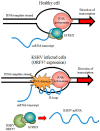Activation of DNA Damage Response Induced by the Kaposi's Sarcoma-Associated Herpes Virus
- PMID: 27258263
- PMCID: PMC4926388
- DOI: 10.3390/ijms17060854
Activation of DNA Damage Response Induced by the Kaposi's Sarcoma-Associated Herpes Virus
Abstract
The human herpes virus 8 (HHV-8), also known as Kaposi sarcoma-associated herpes virus (KSHV), can infect endothelial cells often leading to cell transformation and to the development of tumors, namely Kaposi's sarcoma (KS), primary effusion lymphoma (PEL), and the plasmablastic variant of multicentric Castleman's disease. KSHV is prevalent in areas such as sub-Saharan Africa and the Mediterranean region presenting distinct genotypes, which appear to be associated with differences in disease manifestation, according to geographical areas. In infected cells, KSHV persists in a latent episomal form. However, in a limited number of cells, it undergoes spontaneous lytic reactivation to ensure the production of new virions. During both the latent and the lytic cycle, KSHV is programmed to express genes which selectively modulate the DNA damage response (DDR) through the activation of the ataxia telangiectasia mutated (ATM) pathway and by phosphorylating factors associated with the DDR, including the major tumor suppressor protein p53 tumor suppressor p53. This review will focus on the interplay between the KSHV and the DDR response pathway throughout the viral lifecycle, exploring the putative molecular mechanism/s that may contribute to malignant transformation of host cells.
Keywords: DNA damage response; cancer; kaposi; sarcoma; skin; tumor.
Figures



References
-
- Rezza G., Tchangmena O.B., Andreoni M., Bugarini R., Toma L., Bakary D.K., Glikoutou M., Sarmati L., Monini P., Pezzotti P., et al. Prevalence and risk factors for human herpesvirus 8 infection in northern Cameroon. Sex Transm Dis. 2000;27:159–164. doi: 10.1097/00007435-200003000-00008. - DOI - PubMed
-
- Serraino D., Toma L., Andreoni M., Buttò S., Tchangmena O., Sarmati L., Monini P., Franceschi S., Ensoli B., Rezza G. A seroprevalence study of human herpesvirus type 8 (HHV8) in eastern and Central Africa and in the Mediterranean area. Eur. J. Epidemiol. 2001;17:871–876. doi: 10.1023/A:1015678312153. - DOI - PubMed
Publication types
MeSH terms
LinkOut - more resources
Full Text Sources
Other Literature Sources
Research Materials
Miscellaneous

